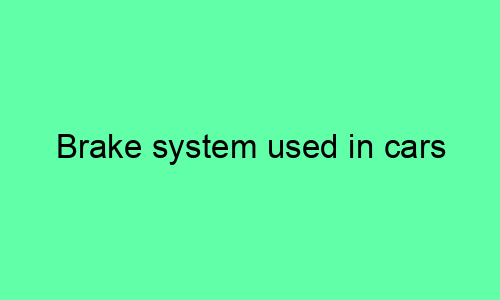**
The Importance of Brake Systems in Cars
**
In the realm of automotive engineering, the brake system stands as a critical component, ensuring the safety and control of vehicles. Brakes enable drivers to slow down or bring their cars to a halt, preventing collisions and potential accidents. Without a reliable brake system, the operation of a car would be dangerously unpredictable.
**
Types of Brake Systems
**
Over the years, various types of brake systems have been developed, each with its unique characteristics and advantages. The most commonly encountered brake systems in modern cars are:
**Hydraulic Brake Systems:**
Hydraulic brake systems utilize brake fluid to transmit force from the brake pedal to the brake calipers. When the driver presses the brake pedal, the master cylinder pressurizes the brake fluid, which flows through brake lines to the calipers. The calipers contain pistons that actuate brake pads, which in turn come into contact with the brake rotors to slow down or stop the wheels.
**Advantages:**
* Precise and responsive braking
* High braking force
* Easy to maintain
**Disadvantages:**
* Prone to leaks and fluid loss
* Can be affected by extreme temperatures
**Disc Brake Systems:**
Disc brake systems are commonly used on the front wheels of cars. They consist of a brake disc (rotor) attached to the wheel hub and a brake caliper that houses brake pads. When the brake pedal is depressed, the caliper applies pressure to the brake pads, causing them to grip the rotor and slow down the wheel.
**Advantages:**
* Excellent heat dissipation
* Durable and long-lasting
* Reduced brake fade
**Disadvantages:**
* More expensive than drum brakes
* Can generate noise and vibration
**Drum Brake Systems:**
Drum brake systems are often used on the rear wheels of cars. They consist of a brake drum attached to the wheel hub and brake shoes that are contained within the drum. When the brake pedal is pressed, the brake shoes are forced outward, making contact with the inner surface of the drum to slow down the wheel.
**Advantages:**
* Less expensive than disc brakes
* Self-adjusting
**Disadvantages:**
* Poorer heat dissipation
* Longer stopping distances
**
Components of a Brake System
**
The brake system of a car comprises several interconnected components that work together to bring the vehicle to a stop. These components include:
* **Brake Pedal:** The brake pedal is the primary control for the brake system. When the driver presses the brake pedal, it activates the master cylinder.
* **Master Cylinder:** The master cylinder converts the mechanical force from the brake pedal into hydraulic pressure, which is then transmitted to the brake calipers or wheel cylinders.
* **Brake Lines:** Brake lines are flexible hoses or metal tubes that carry brake fluid from the master cylinder to the calipers or wheel cylinders.
* **Brake Calipers (Disc Brakes) / Wheel Cylinders (Drum Brakes):** Calipers or wheel cylinders contain pistons that push the brake pads or shoes against the brake rotors or drums.
* **Brake Pads / Brake Shoes:** Brake pads or shoes are friction materials that make contact with the brake rotors or drums to generate braking force.
* **Brake Rotors / Brake Drums:** Brake rotors or drums are the rotating components that provide a surface for the brake pads or shoes to grip.
* **Brake Fluid:** Brake fluid is a hydraulic fluid that transmits force from the master cylinder to the calipers or wheel cylinders.
**
Maintenance and Troubleshooting
**
Regular maintenance and inspection of the brake system are crucial to ensure optimal performance and safety. Some common maintenance tasks include:
* **Brake Pad Replacement:** Brake pads wear out over time and may need to be replaced to maintain adequate braking efficiency.
* **Brake Fluid Flush:** Brake fluid should be flushed periodically to remove contaminants and ensure proper system operation.
* **Brake Rotor/Drum Inspection:** Brake rotors or drums should be inspected for signs of wear or damage, such as scoring, glazing, or warping.
Troubleshooting brake problems requires a systematic approach, involving:
* **Checking Brake Fluid Level:** A low brake fluid level may indicate a leak or a problem with the master cylinder.
* **Inspecting Brake Pads and Rotors:** Worn brake pads or damaged rotors can lead to decreased braking performance.
* **Testing Brake Lines:** Inspecting brake lines for leaks or damage is essential to ensure proper brake fluid flow.
* **Checking Caliper Pistons:** Seized or sticking caliper pistons can prevent the brake pads from making proper contact with the rotors.
**
Safety Considerations
**
The brake system is a critical safety feature in cars, and its proper functionality is vital for preventing accidents. Drivers should be aware of the following safety considerations:
* **Servicing the Brake System:** Regular servicing of the brake system is essential to maintain optimal performance and safety.
* **Warning Lights:** Ignoring warning lights that illuminate on the dashboard, such as the “brake” or “ABS” light, can indicate potential brake system issues that require immediate attention.
* **Anti-Lock Braking Systems (ABS):** ABS helps prevent wheels from locking during braking, allowing drivers to maintain control and steer the car even during sudden stops.
* **Brake Fade:** Prolonged or severe braking can cause brake fade, resulting in reduced braking power. Drivers should be aware of this phenomenon and take breaks as needed.
**
Conclusion
**
The brake system is an indispensable component in modern vehicles, ensuring the safety and control of drivers and passengers. By understanding the different types, components, maintenance requirements, and safety considerations of brake systems, car owners can contribute to the proper functioning of this vital technology. Regular servicing, troubleshooting, and responsible driving practices are crucial for maintaining a reliable and effective brake system that enhances the driving experience and protects lives.






